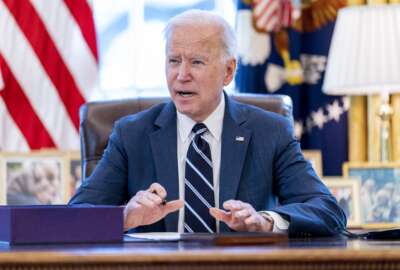DoD budget contains big pay raise and largest research investment ever
The Defense Department is asking Congress for a $773 billion budget in 2023, which it says is crucial to continuing its concept of “integrated deterrence” —...
The Defense Department is asking Congress for a $773 billion budget in 2023, which it says is crucial to implement the Biden Administration’s concept of “integrated deterrence” — using weapons in multiple domains alongside other instruments of national power — as it continues to identify China as the main threat to the United States.
The budget is a good deal larger than the $715 billion that the Biden administration requested last year, but only about 2.2% bigger than what Congress appropriated the Pentagon for 2022. Taking DoD’s projections for inflation into account, the real growth in spending would be about 1.5%, officials said.
Despite the small increases, the military services will see slight, and hopefully temporary drops in end strength, and in some areas, force structure will shrink too. Officials said that’s in keeping with the administration’s new national defense strategy, which the Pentagon also sent to Capitol Hill on Monday.
“Our message here is that the increase in resources is not to make the force bigger,” DoD Comptroller Michael McCord said at the Pentagon Monday. “That’s not what our review concluded we need to do. We’re looking at making the force more capable.”
The largest will be in the Army, where it will temporarily shed 3,000 soldiers. The service says that is because of the tight labor market. Army officials feel they can find high-end talent more easily in later years.
The president’s budget is only a suggestion for Congress. This year lawmakers added $30 billion to DoD’s budget.
DoD’s request is a little behind the times, however. The Pentagon finalized its budget before inflation rose to current levels and before Russia invaded Ukraine. Those two factors could have a big impact on how Congress considers the budget.
“We’re seeing inflationary pressure here in 2022,” Deputy Defense Secretary Kathleen Hicks said. “We just had the omnibus pass. That omnibus did not yet take account of inflation in 2022. We’ll be working with Congress through the summer on how this year lands and how it affects service members.”
Federal News Network first reported that service members and civilian employees will both get a 4.6% pay increase under the President’s budget. That’s the largest increase in 20 years. DoD civilians making minimum wage will have their pay increased to $15 an hour.
Hicks said DoD will also look at possible adjustments to basic allowance for housing.
The budget is putting a strong emphasis on the future. The document proposes a 9.5% increase in research and development, totaling $130 billion. It accounts for the largest research budget in the history of the military. That will go into things like 5G, artificial intelligence and basic research.
DoD is also securing its supply chains by prioritizing five areas to expand the industrial base: microelectronics, casting and forging, batteries, kinetic capabilities and strategic minerals. DoD will put about $4 billion into those area by expanding suppliers and rebuilding the national stockpile.
The Pentagon is increasing its presence in the cyber sphere by asking for five new Cyber Mission Force teams. About $27.6 billion will go to space capabilities, including GPS III and satellite communications.
For the first time, the Pentagon is breaking out a budget area to address climate change, requesting $3 billion to bolster security in the near-term and lay groundwork for adaptation and resilience on bases and contingency preparedness.
In the realm of the military services, the Department of the Air Force comes out with the biggest increase. That service is requesting nearly $170 billion, $6 billion more than what Congress gave it in 2022. The Space Force is requesting $24.5 billion, a 35% increase over the 2022 Congressional appropriation.
Those funds will go to modernization and transformation of the service. About $1.3 billion will fund the Ground-Based Strategic Deterrent and nearly $6 billion would go to a new missile warning and tracking design.
The Department of the Navy will also see a larger increase with a request of $180.5 billion for the Navy and $50.3 billion for the Marine Corps. That’s a total increase of about $9 billion. Some of that money would pay for a new frigate and two Virginia-class submarines.
The Army’s budget will remain relatively flat, a 1.7% increase. It is asking for $178 billion.
Responses to the budget run the gamut. Republicans are concerned that they budget isn’t big enough, pointing to a letter they wrote last week asking for at least 5% growth to offset inflation.
“Real growth — 5 percent above inflation — is what we need if we are to meet this moment,” said Sen. Jim Inhofe (R-Okla.), ranking member on the Senate Armed Services Committee. “We must do more to change the military balance of power in the next five years. Our naval fleet will still shrink in this request. Air Force aircraft procurement remains anemic. While core nuclear modernization efforts remain on track, cuts to key capabilities like the sea-launched cruise missile mean we will lose ground against China’s and Russia’s rapidly expanding arsenals.”
Inhofe noted that he saw some positives in the budget like the increase in research spending.
Senate Armed Services Committee Chairman Jack Reed (D-R.I.) said he thought the budget showed promise and said the committee will consider it in its legislation going forward.
“Amidst a global pandemic, climate change, economic uncertainty, and disruptive technologies in the hands of competitors, we have to recognize the interconnected nature of the threats before us,” he said. “Congress must make thoughtful decisions about how we resource and transform our tools of national power. Now that President Biden has issued his budget request, the Committee can begin our work of crafting a national defense authorization bill that meets America’s needs now and in the future.”
Copyright © 2025 Federal News Network. All rights reserved. This website is not intended for users located within the European Economic Area.
Scott Maucione is a defense reporter for Federal News Network and reports on human capital, workforce and the Defense Department at-large.
Follow @smaucioneWFED







